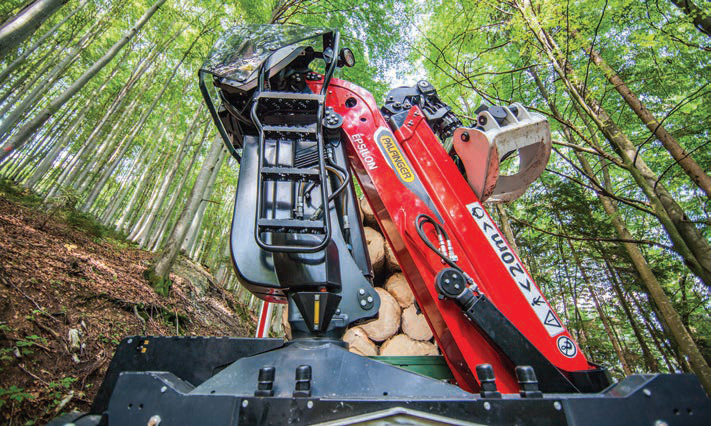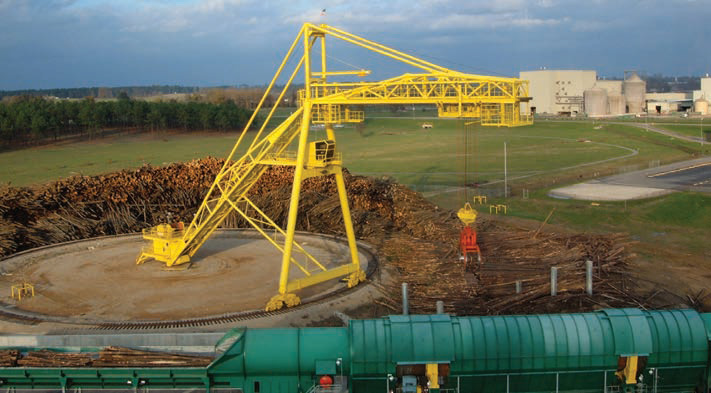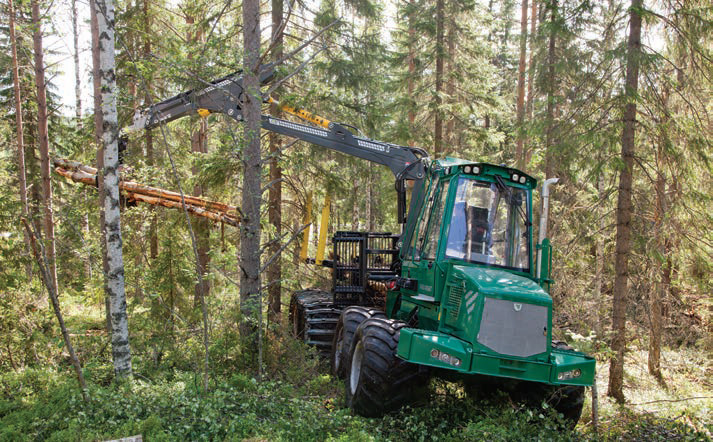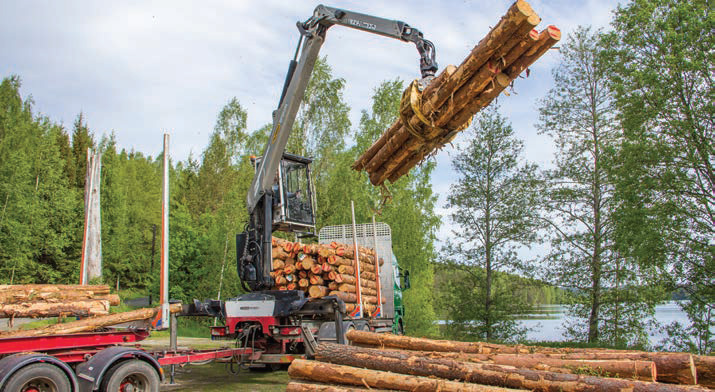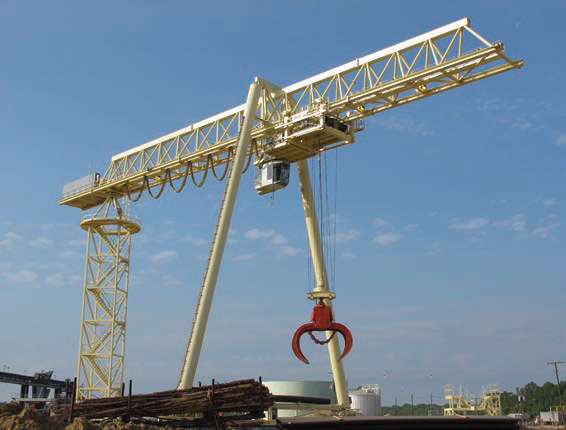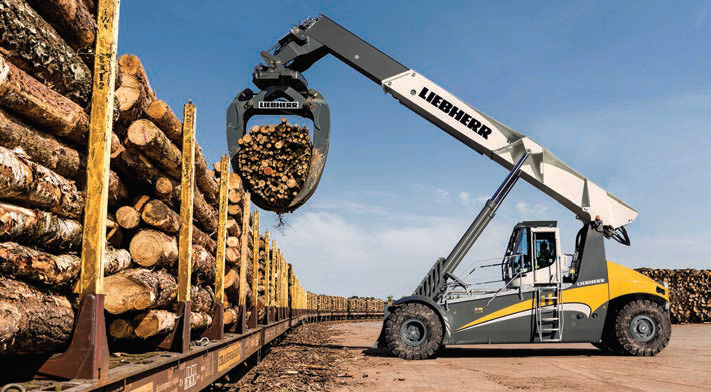Good for wood
21 March 2019Sustainability, disenchantment with plastic, and the use of new wood products such as cross-laminated timber in construction are placing new emphasis on the timber industry. Julian Champkin looks at the cranes that serve the industry.
Forestry and timber is a large and, if you will forgive the expression, a growing industry. It is also one that involves much lifting. Some of it is relatively light: in the forest a single tree will generally weigh less than a tonne. Some of it is heavy: at the mill’s woodyard, roundwood logs—tree trunks in other words —are fed into the saw-mill or the pulping or chipping machines dozens at a time by huge overhead gantry cranes whose typical lift can be 20 or 30t and which operate 24/7, running on rails that can be as much as a mile in length. Cranes used in forestry are correspondingly specialised.
To start at the beginning, in the forest. Two types of cranes are commonly used here: harvester cranes and forwarder cranes.
Harvester cranes are for thinning and felling. Mounted on rubber-tyred carriers, they carry a purpose-built harvester head at the end of an articulated and telescopically-extendable boom. The head is an integrated combined unit that grasps hold of the tree and cuts it. Then as the crane lifts and turns the trunk to horizontal the head in mid-air strips the trunk of its branches, cuts it to length if required, points it in the right direction and lowers it to the ground to form a small stack. (The tree free-falling to the cry of “Timber…!” is no longer part of modern forestry).
Prime requirements for these harvester cranes are ruggedness and reliability, and the ability to work in very rough and steep terrain (trees frequently grow high on mountainsides sides where nothing else will grow) and in confined spaces: trees grow close together, and undergrowth, boulders and ravines are just some of the hazards. Design essentials are lightness, manoeverabilty, and quick and agile movements of the boom. The HC 185 from Swedish forestry-equipment makers Cranab, part of Fassi Group, is an example. Cranab’s harvester cranes come in capacities of 2.46t to 3.84t and reaches from 8.6 to 11.1m.
After the harvester comes the forwarder. The forwarder is a crane equipped forestry vehicle that picks the logs from the ground, loads them into its cradle and transports them to the roadside. The crane element of the forwarder will be a knuckleboom, but again with telescopic sections and specialised design features. “The issue here is to take as big a load as possible in one single trip, and to load and carry as fast as possible,” says Jonas Järnö, off-road sales manager for Cranab. “But the ground may be rough, steep and bumpy; so, the load cradle is wide, rather than high, for stability.”
Forwarder cranes have a perhaps unexpected design feature: “Much loading takes place with the crane parked at an angle on steep ground. If you think of a crane arm slewing to lift the load round its cradle, if the axis of rotation is not vertical the strain on the crane, and the power required to slew it, are both very great. To avoid this our cranes have slewing axes that are tiltable. The tilt is variable, by up to 20° degrees, so that the slewing axis can be pointed vertically to the sky no matter what slope the vehicle is parked on.”
Digital automation has entered forestry. The Cranab Intelligent System constantly senses the positions of each part of the crane, from the slewing engine out to the crane’s nose. Recurring movement patterns, such as unloading onto the cargo cradle or to the truck, can be fully or partly automated; collisions with the cab or supporting stakes in the cargo bay are automatically prevented.
“There are two different ways of carrying out logging,” says Järnö. “They are known as whole-tree and as cut-to-length.” Whole-tree is what it says: the tree is felled, stripped of its side-branches and sent full-length to the mill.
In cut-to-length operations the harvester crane not only fells the tree but cuts it to a standard length, five to six metres, before it is loaded onto the trucks. It may seem a trivial difference, but it has consequences.
“Mills are large-scale operations, which are designed exclusively to handle one or other of the types of arriving roundwood” says Järnö. “In Sweden, and in Europe generally, cut-to-length is by far the most usual, though some mills in Austria use whole-tree. In North America, whole-tree is standard.”
Forwarder cranes for whole-tree operation have to be bigger and stronger; equipment as a whole has to be heavier. “This causes more damage to the soil, and impacts badly on re-planting the forest after harvesting,” says Järnö.
The forwarder has got the roundwood logs to the truck; the truck’s crane also has special features. “The maximum width for road transport is 2.5m,” he adds.
“Maximum road weights used to be 60t but in recent years some countries have increased this to 74t. This means the loads are high; but clearances under bridges and overhead cables are unchanged.
The truck’s knuckleboom crane needs a long reach, but for travel needs to stack flat and close to the load so as not to increase the overall height.”
Epsilon, the forest-crane arm of Palfinger, produce two types of truck crane for timber: the L-crane and the Z-crane. The L-crane, they say is traditionally a Scandinavian favourite; the long main boom and shorter knuckle-boom give it its name. Geometry dictates that the longer the main boom, the less it has to be moved, so the operator can focus on finer manipulation of the knuckle. Its long reach of 9.7m means that the operator does not constantly have to reposition the truck to be able to load the logs.
Epsilon’s Z-crane has an extra joint and is much more compact, so it can be folded transversely to the direction of motion, behind the log load. This means that it does not add to that all-critical height of the load. The new design of the double-telescope system gives their latest model, the M12Z, a 10.5m reach.
Not all transport is by road: rail is widely used, and the L-crane, says Epsilon, is increasingly being deployed for unloading onto rail wagons. Water transport is also common. Liebherr have a new product on the way, the LRS Log Handler. Currently in the testing phase, it is based on the company’s Reachstacker, which is built by the Liebherr’s maritime crane division. The LRS Log Handler will find its application mainly at heavy-duty log transferring sites in sea ports and inland locations. It is due to be released later this year.
At the woodyards, the scale of lifting operations makes a several orders- of-magnitude jump, in the form of the woodyard portal gantry cranes that unload the trucks and, later, move the logs from the stockpiles into the mills. What happens in the way of lifting gear inside the mills has been covered in the March issue of our sister magazine Hoist; but the cranes that feed those mills can be truly massive machines.
“There are basically three types of woodyard crane,” says Teddy Berman, sales manager for woodyard and portal cranes for Konecranes. “There is the straight track portal crane, the rotating portal crane, and the traditional log boom crane. Both of the latter rotate, with multiple sets of wheels on a circular runway rail and a pivoting support at the centre of the circle. With a portal crane, whether rotating or straight-track, the trolley can run between the supporting legs and so store logs inside or outside the area of the runway rail; a traditional log boom crane’s grapple cannot reach inside that centre circle, so that space can’t be utilized for storage. Since the circular runway of a rotating portal crane can be well over 300ft (100m) in diameter, that design gives a huge increase in inventory capacity.”
In a woodyard, inventory efficiency is a critical consideration, which is one reason why portal cranes on rails have taken over from rubber-tyre mobile equipment for this work.
Rubber-tyre equipment needs road space between the woodstacks; overhead cranes do not, so the saving can amount to a large percentage of the storage space.
“There can be well over 100,000t stored in a yard under these cranes” says Berman. “This is especially true for our customers in Canada, where the haulage season is short. They do winter hauling in the three or four months when the forest roads are frozen hard, and during those months they haul as much of their entire year’s cut as possible down to the mills. By the end of the winter haul, the woodyards have accumulated huge stocks, and they run off that timber all year."
This puts a great premium on the size, the speed and the robustness of the woodyard cranes. “At peak times they can be unloading over 500 trucks a day in daylight hours, and loading up and feeding the mill through the night as well,” he says.
“Our portal cranes are CMAA Class F machines, which means they operate continuous heavy-duty cycles at or near the capacity of the crane. Thirty to thirty-five tons of logs per pick is common. They use cable-reel electrical power supply, at high voltage, with a transformer on the gantry. This again represents a saving over diesel-powered mobile equipment. As compared to wheeled equipment, the safety and efficiency improvements are clear, as well as the long-term cost effectiveness and return on investment.”
Speed is also important. “Many truck drivers in North America are independent operators, so a mill’s turn-around time is critical to them.
They may have five available mills within a reasonable driving radius; if at one mill they have to wait fifteen minutes to unload, and at another they wait an hour and a half, it is a no-brainer for them which they will go to. One extra load can add 50% to their day’s earning.”
“Cycle times are critical, so two-crane set-ups can help here.” The mills, which may be saw-mills for lumber, pulp-mills for papermaking, or chippers for wood-based panels, operate continuously, so minimizing downtime for the cranes feeding them is also critical. Design principles help here, says Berman, as does experience. “There is a long legacy of portal cranes behind the Konecranes brand,” he says. “In 1977 the first two Heede latticegirder woodyard portal cranes were sold. Today Konecranes builds on that proven legacy.”
“The girder structure of a portal cranes is a lattice design rather than solid beam” he says, “and the supporting legs are pinned to it. The sill beam, running just above the rail, keeps the bottom of the legs connected and aligned. The design allows for a natural flexing of the structure under load. This flexibility in turn puts much less side strain on the legs, the wheels, and the rail tracks, so fatigue wear on those elements is greatly reduced. Our cranes have been in Class F service since the 70s and 80s; we like to celebrate 30th and 40th birthdays as they come along."
Major improvements today are in digitisation. “Crane controls have come a long way since 1977” says Berman. “We have variable frequency drives specially tuned for crane motions, on-board software integration for customizable inventory management, and monitoring and diagnostics systems connecting to a secure online portal.”
Konecranes’ system is called TruConnect. “It monitors equipment usage and maintenance history, tracks wear items for preventative maintenance, and can automatically alert stakeholders with text message and email notifications of safety and productivity issues,” Berman says.
“Soon we’ll be introducing Remote Operating Station technology to woodyard cranes, after a proven history in similar applications. Relocating the operator to offboard the crane adds yet another level of safety and productivity to the log-handling process, both on new equipment and retrofitting legacy cranes. We have a dedicated woodyard crane service and modernizations team to support these machines – we understand how critical both safe operation and up-time is for our forest products customers.”
Arkansas-based Timber Automation also make radial and lineal log cranes, similarly aimed at forest product users processing over 500,000 green tons of roundwood per year – green meaning freshly cut; as logs dry out their weight decreases markedly. Their flagship crane is the continuous duty, Class F, Radial Log Crane by LogPro which surpasses the requirements of CMAA 70 specifications. Capacities range from 25 to 60USt and from 125ft to 175ft. The radial system loads the centre pivot with concrete to supply enough counterweight to prevent the crane toppling forward should the pivot fail. Linear design allows for multiple truck unloading areas and have the advantage, they say, of expandability: for more space you just extend the rail runway. A special feature of LogPro lineal cranes is having rail and support structures elevated off the ground. This allows the use of a buss bar electrical feed system and eliminates the need for a cable reel. It also, they say protects the rail from debris and falling logs. Both radial and lineal log cranes can unload an entire truck in one or two picks.
“Demand for forest products is steadily growing,” says Berman, “for all kinds of reasons. There is sustainability in consumer products, there is modular building and new types of composite wood for construction, and online shopping and e-commerce means that a product that already comes in a good bit of packaging is put in another cardboard box for delivery. All this has really helped the forest products business. It is a strong segment of the global market, and we’re proud to be an integral part of it.”
In forestry, the source of the money does indeed grow on trees, but it needs careful and specialised handling to realise it.
